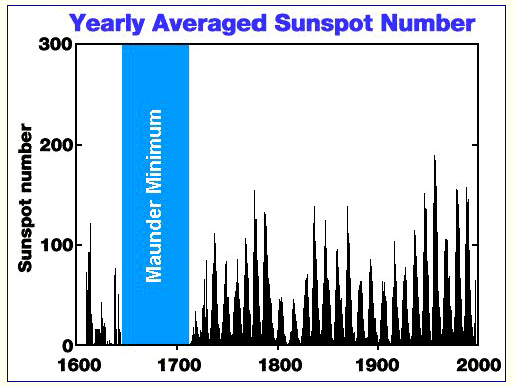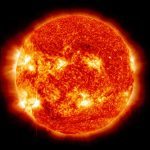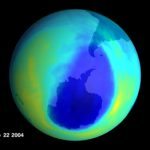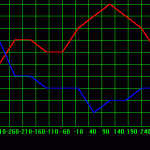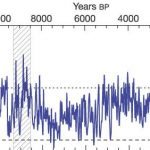The most well-documented connection between solar activity and climate change is the Maunder Minimum. This was a 40-year period when extreme cold weather prevailed in Europe. It also coincided with astronomers watching the sun and not seeing many sunspots! Astronomer Jack Eddy pointed this out in the 1970’s, and since then many other sun-climate connections have been looked for and in some cases uncovered.
Scientists have examined the climate record for other signs of the connection between space weather and climate-weather changes with many surprising results listed below.
The sunspot cycle and Boston Weather…. This study by Dave Henry at NOAA is based on 207 years of daily temperature data from Boston. It shows a 0.8 F drop in the average annual temperature near sunspot maximum, a 3-inch difference in the annual average precipitation near sunspot maximum, and a 7-inch increase in annual average snowfall at sunspot maximum.
The sunspot cycle and Temperature and Precipitation in the United States…This study by Daniel Hancock and Douglas Yarger at Iowa State University was published in the Journal of Atmospheric Sciences (vol. 36 pg 746). They found a statistically significant correlation between the 21-year Hale cycle and the ‘January Thaw’ phenomenon on the East Coast, and with the June temperature and precipitation of the ‘drought’ cycle in the Midwest.
The sunspot cycle and Annual Precipitation in Tenerife…This study, published by Xavier Calbert and his colleagues in the journal Atmospheric and Oceanic Physics (2001, October 29) is based on rainfall data from 1916-1998 and 8 sunspot cycles. A curious correlation is found in which the maximum precipitation lags the sunspot maximum by three years.
The sunspot cycle and Annual Precipitation in Beijing…. This article by Juan Zhao and his colleagues at Beijing Normal University was published in the Chinese Journal of Astronomy and Astrophysics (2004, vol 4 pg 189) and is based on rainfall records from 1870 to 2002. Their wavelet analysis of the rainfall data identifies four periods of 11, 22, 33 and 72 years. The wavelet analysis of the sunspot data for the same period reveals periods of 11, 22, 33 and 78 years.
The sunspot cycle and Precipitation at Armagh Observatory…. This study of the rainfall record for Armagh Observatory by C. J. Butler, A. Coughlin and D. Fee was published in the Proceedings of the Royal Irish Academy (1998, vol 98B, pg 123) and covers the years from 1838 to 1997. Mean seasonal rainfall is correlated with the North Atlantic Oscillation, but no statistically significant correlation is found with the 11-year sunspot cycle.
The sunspot cycle and Extreme Weather over Portugal…. This 2005 study by P.S. Lucio at the Center for Geophysics in Evorea was published in the Geophysical Research Abstracts (vol. 7 p. 129) and is based on cosmic ray and rainfall data from 1901-2000. A statistically significant correlation was found between rainfall and temperature extremes, and cosmic ray fluxes beginning in 1980.
The sunspot cycle and Cosmic Rays…. There is a well-known anti-correlation between times of sunspot maxima and times of maximum cosmic ray detections at ground stations. This relationship is now understood to be due to the solar magnetic field providing more shielding to the inner solar system at sunspot maximum, so that fewer cosmic rays reach earth. This resource at the NOAA National Geophysical Data Center gives some details.
The sunspot cycle, Cosmic Rays and Cloud Cover…. This study by Ken Carslaw at the University of Leeds published in the November 29, 2002 issue of the journal Science (page 1732) describes a simulation experiment at CERN to investigate how cosmic rays can influence water droplet condensation which leads to the correlation established between cloud cover and cosmic rays.
The sunspot cycle and Cloud Cover …. This 1997 study by Svensmark and Friss-Christensen was published in the journal Atmospheric, Solar and Terrestrial Physics. It is considered by many researchers as the first clear indication that cloud cover varies in phase with cosmic ray intensities suggesting a close cause-and-effect-relationship. Because cosmic rays are anti-correlated with the 11-year sunspot cycle, this predicts that cloud cover is modulated by solar activity in a non-direct way.
The sunspot cycle and the Global Stratosphere…This study by H. van Loon and K. Labitzke at the National Center for Atmospheric Research (NOAA) shows that the heights and temperatures of the lower stratosphere vary in step with the sunspot cycle. It was published in the Journal of Atmospheric and Solar-Terrestrial Research (1999, vol. 61 pg. 53) and is an extension of a Northern Hemisphere study that they completed in 1997. The correlation between the sunspot cycle and the zonally averaged temperatures are highest between the tropopause and the 25-km level of the ozone layer.
More From SolarStorms.org:
Submit your review | |

